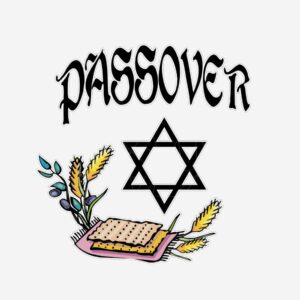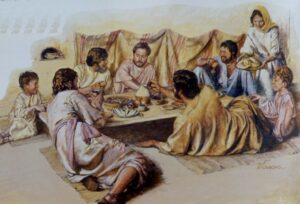A Gospel Contradiction of the Resurrection?
Cited by critics and skeptics is a seeming contradiction is between the Matthew and John Gospel Resurrection accounts of Jesus of Nazareth as proof the Gospels’ lack integrity.[1] At first glance, a contradiction indeed appears to exist, but is there really one?
Matthew reports “they” were interrupted with a resurrection appearance by Jesus and when compared to John, it poses potential conflict. John 20:12-16 details the lone Mary Magdalene Resurrection encounter with Jesus at the tomb. How can both be correct?
MT 28:9 “Suddenly Jesus met them and said, “Greetings!” And they came to him, took hold of his feet, and worshiped him.” NRSV
Named in Matthew are two women present at the tomb during the angelic incident, Mary Magdalene and the other Mary. Mark and Luke together also identify Joanna, Mary the mother of James, Salome and “other women” of Galilee also at the empty tomb, at least 6 women. Mary Magdalene and the other women hurried to tell the Disciples of their experience.
Greek text words of kai idou begins the sentence of Matthew 28:9. The actual meaning of the Greek words provide important clues as part of the literary assessment.
A conjunction, kai is interpreted the same in almost all English Bible translations. Appearing over 9000 times in the New Testament Greek texts, about 98% translate kai as “and.”[2]
Second is idou, appearing about 200 times in the New Testament Greek texts where over 90% of 32 translations use English words of exclamation that do not denote a specific point of occurrence, such as “Behold,” “Look,” “Suddenly,” or “lo.” Barely more than just 6% use a word that indicates a specific point in time, such as “here” or “now.”[3]
Using the most common English translations of kai idou in Matthew 28:9, the verse would begin with something like, “And look” or “And behold.” Bottom line: the timing of this encounter with the resurrected Jesus is not specific.
Flipping over to John 20:12-16, at least some of the women including Mary Magdalene ran to the location of two Disciples, Peter and John, to report the empty tomb. The two Disciples then ran to the tomb to see for themselves.
Mary Magdalene followed Peter and John back to the tomb, according to John’s Gospel, while Luke reports that only Peter ran back to see the empty tomb. Had all the Disciples been present at the location where Mary made her exclamation, logic dictates all the Disciples would have gone to see the empty tomb with Peter and John.
Keep in mind, John’s account is an eyewitness statement and Luke’s account is written from the perspective of an investigative reporter with one of his main sources being Peter. Both statements are consistent even though John is not mentioned in Luke’s account. Luke’s Gospel reports that all the Disciples and others were told details of the incident at the tomb, but the author doesn’t specifically say when.
John’s account does not indicate if the other women of Galilee were with Mary Magdalene when she returned to the tomb – there is no mention of them. Not surprising since these women had already been there; the other time that morning was a traumatizing experience; and they knew the tomb was empty anyway.
Mary waited as the two Disciples inspected the empty tomb; saw the burial clothes; and marveled at what they had witnessed. Peter and John then returned to the city leaving Mary Magdalene behind, weeping. Time required for this second interlude at the tomb is subjective although it is probably more than just minutes.
Then it happened, Jesus appeared at the tomb only to Mary Magdalene.
JN:20:16 Jesus *said to her, “Mary!” She turned and *said to Him in Hebrew, “Rabboni!” (which means, Teacher). NASB
Consistent with the NET and King James Bible translations, Jesus told Mary Magdalene not to “touch” him because he had not yet ascended to “My Father.”
JN 20:17 “Jesus saith unto her, Touch me not; for I am not yet ascended to my Father: but go to my brethren, and say unto them, I ascend unto my Father, and your Father; and to my God, and your God.” KJV
Understandably excited, Mary Magdalene wanted to hug Jesus, but his response was don’t haptou or haptomai me.[4] Again, the Greek word’s meaning is a very important detail where translation nuances can make a big difference.
Greek texts of the New Testament have at least 32 various instances of haptomai with 28 instances appearing in the four Gospels. All instances are translated in the NET version as a form of “touch.” The King James Bible translates haptomai in John 20:17 as “touch me not.”
That said, John 20:17 is translated differently in most Gospel versions. Greek word haptomai is translated in only about 28% of instances as “touch” or “touched.” The remainder of translations use English words implying that touching has already occurred, such as “hold” and “cling.”[5]
Question: Was Mary Magdalene allowed to “touch” Jesus when he appeared to her? Depending on the translation, Mary was not allowed to “touch” Jesus in John’s account because he had not yet ascended to his “Father.” Matthew’s account, not affected by translation variances, says the “women” wrapped their arms around his feet and worshiped Jesus.
If Mary was not allowed to touch Jesus, it then corroborates the incident described in Matthew’s account after Jesus had presented himself to God. The circumstances are completely different between John and Matthew: one vs. many; not touched vs. touched.
Pieces of the puzzle are coming together. Much of the day on Sunday remained when the other Disciples could have been informed by the women of Galilee at the tomb at sunrise. Whether Mary Magdalene was with the women in the Matthew encounter is not clear; however, based on the preceding verses in Matthew, it is likely she was with them.
An actual eyewitness statement is always of great value and there is one – Cleopas‘ statement quoted in Luke’s Gospel account. Heading back home, Cleopas and his partner were unwittingly joined along the way by the resurrected Jesus.
Cleopas stated, “Some of those who were with us went to the tomb and found it just exactly as the women also had said; but Him they did not see.” Most significantly, no one had encountered the resurrected Jesus.
John’s Gospel is corroborated by the statement of Cleopas on key details: women reported their experience at the tomb; the tomb was empty; and only “some” went to verify the empty tomb.
Is there really a Gospel Resurrection conflict or were there two different incidents described by the Gospels of Matthew and John?
Updated September 25, 2023.
This work is licensed under a Creative Commons Attribution-NonCommercial-NoDerivatives 4.0 International License.
REFERENCES:
[1] Cline, Austin. “Jesus: Contradictions in Resurrection and Ascension.” Learn Religions. 2019. <https://www.learnreligions.com/jesus-resurrection-and-ascension-contradictions-250145> Lowder, Jeffery Jay. “The Historicity of Jesus’ Resurrection The Debate between Christians and Skeptics.” TheSecularWeb. Chapter 4. 1995. <https://infidels.org/library/modern/jeff_lowder/jesus_resurrection/chap4.html> Seidensticker, Bob. “Contradictions in the Resurrection Account.” Patheos.com. 2012. <https://www.patheos.com/blogs/crossexamined/2012/04/contradictions-in-the-resurrection-account-2> Heuvel, Curt van den. “The Resurrection of Jesus Christ.” 2Think.org. 1997. <http://www.2think.org/hundredsheep/bible/ressur.shtml> Agard, Margaret. In His Footsteps. “The Tomb Is Only Empty Because Christ is Risen.” image. 2013. <https://inhisfootsteps.com/wp-content/uploads/jesus_christ_empty_tomb_goshen_utah.jpeg>
[2] “kai.” Netbible.org. Matthew 28:9. kai <2532>. 2020. Matthew 28:9. Footnote 1. NetBible.org. 2020. “kai.” BibleHub.com. Strong’s Greek 2532. 2011. “kai <2532>.” NetBible.org. 2020. ;
[3] “idou.” NetBible.org. 2020. <http://classic.net.bible.org/strong.php?id=2400> Matthew 28:9, Footnote 1. NetBible.org. 2020. <http://classic.net.bible.org/verse.php?book=Mat&chapter=28&verse=9#> “2400. idou.” Bi-bleHub.com. 2020. <https://biblehub.com/greek/2400.htm> “idou.” BibleHub.com. Strong’s Greek 2400. 2020. <https://biblehub.com/parallel/matthew/28-9.htm> Matthew 28:9. Bi-bleHub.com. Interlinear. 2020. <https://biblehub.com/interlinear/matthew/28-9.htm> Matthew 28:9. BibleHub.com. Lexicon. 2020. <https://biblehub.com/lexicon/matthew/28-9.htm> Matthew 28:9. BibleHub.com. 2020. <https://biblehub.com/matthew/28-9.htm> Matthew 28:9. NetBi-ble.org. 2020. <http://classic.net.bible.org/verse.php?book=Mat&chapter=28&verse=9>
[4] “haptomai.” NetBble.net. 2020. <http://classic.net.bible.org/strong.php?id=680> “ἁψάμενος.” Bi-bleHub.com. 2020. <https://biblehub.com/greek/apsamenos_680.htm> “ἅπτου.” BibleHub.com. 2020. <https://biblehub.com/greek/haptou_680.htm> John 20:l7. BibleHub.com. Parallel. <https://biblehub.com/john/20-17.htm> John 20:17. NetBible.org. <http://classic.net.bible.org/verse.php?book=Joh&chapter=20&verse=17>
[5] “haptomai.” NetBble.net. n.d. <http://classic.net.bible.org/strong.php?id=680> “ἁψάμενος.” John 20:17. BibleHub.com. n.d. interlinear. <https://biblehub.com/interlinear/john/20-17.htm> John 20:17. BibleHub.com. n.d. lexicon. <https://biblehub.com/lexicon/john/20-17.htm> “G0680.” Lexicon Concordance. n.d. <http://lexiconcordance.com/greek/0680.html>

 Final days of Jesus of Nazareth took place during the annual Passover observance in
Final days of Jesus of Nazareth took place during the annual Passover observance in 